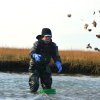Dr. Rip comes to Dewey
In the name of science, Dr. Robert Brander purposely throws himself into rip currents with a GPS strapped to his head.
“I've been in a ton of rips,” he said July 9, standing on Dewey Beach. “But there are still times I'll start to get that little flutter in the heart even though I know what's happening.”
Brander, known as Dr. Rip, is an associate professor from the School of Biological, Earth and Environmental Sciences at the University of New South Wales in Sydney, Australia, traveling the world on a research sabbatical to study rip currents and their characteristics.
His sabbatical brought Brander to Delaware July 7-15, where he is talking with local beach patrols and marine professionals about their experience with the Cape Region's local rip current conditions.
Delaware has a different kind of rip than most locations, said Brander. He explained that the shoreline along Delaware's beaches is relatively shallow, which causes flash rips that appear out of nowhere in unpredictable locations. These rips, said Brander, can stick around for 10 minutes and then, in a second, they can show up 100 yards down the beach.
“The water piles up and then shoots off shore,” he said.
Brander's visit is hosted by Delaware Sea Grant, a University of Delaware research and outreach program based in Lewes.
Wendy Carey, coastal hazards and resiliency specialist for the university program, met Brander for the second time. The two met five years ago when Brander was on an earlier research trip. He said Carey was a key player in establishing a nationwide rip current education and safety campaign called "Break the Grip of the Rip", sponsored by Sea Grant, the National Weather Service and the United States Lifesaving Association.
The goal of the program is to promote a clear and consistent message on rip currents, said Carey. According to the campaign's website, the accepted method to break a rip current's grip is to swim parallel the shoreline and then swim at an angle back to shore. Signs demonstrating this technique are posted up and down the state's beaches, on boardwalks and on the back of lifeguard stands.
Both Brander and Carey said one of the tools of their research is interviewing people who have been caught in a rip current and lifeguards who have pulled someone out of one.
The problem is, said Carey, rip conditions are very local. In Delaware the rips tend to be shorter and don't pull swimmers out too far, said Carey, but in California they can pull someone 100 to 200 yards off shore.
“And that can be scary,” she said.
The most important thing for someone caught in a rip current, Brander said, is not to panic. Rips don't pull a swimmer under, he said. Just remain calm and signal to a lifeguard that help is needed.
He added that taking a few precautions before entering the water, such as talking with the lifeguards and checking the conditions report, help swimmers remain safe.
Brander said as a way to gather information, he has created a website where people who have been caught in rip currents can anonymously fill out a questionnaire. He said it takes 10 minutes and encouraged anyone who has experienced a rip current first hand to go to www.ripcurrentsurvey.com.
Chris Flood has been working for the Cape Gazette since early 2014. He currently covers Rehoboth Beach and Henlopen Acres, but has also covered Dewey Beach and the state government. He covers environmental stories, business stories and random stories on subjects he finds interesting, and he also writes a column called Choppin’ Wood that runs every other week. He’s a graduate of the University of Maine and the Landing School of Boat Building & Design.
























































